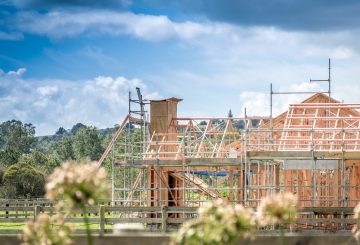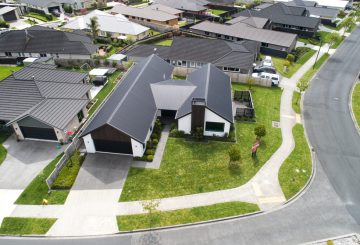長年にわたって住宅市場を牽引してきた主要なメガトレンドは、インフレ圧力の長期的な低下であり、そのために金利が大幅に低下し、借入のインセンティブが高まる一方で、貯蓄のインセンティブが低下したことです。これを増幅させたのが、2008年の世界金融危機とその後の金利引き下げ、そして海外での量的緩和策でです。
また、一世帯あたりの所得が増加する傾向にあり、これは他の要因によるものかもしれませんが(そして、このこと自体が住宅価格の上昇に寄与しています)、おそらく住宅価格自体の上昇の循環的な症状であると思われます。不動産を購入するためには、もっと働かなければならなくなったのです。
2011
世界金融危機から3年経った今でも、住宅市場はかなり静かで、販売も価格も落ち着いています。
手頃な価格であることは確かですが、一戸建ての購入は特に活発ではなく、純移動はマイナスで、住宅建設許可は低い水準にあります。この時期は、建設に対する信頼が揺らぎ、住宅不足という負の遺産を残したまま、現在に至っています。
新規住宅建設許可件数
グラフは、2011年から2021年第3四半期までの新築住宅建設許可件数の、四半期ごとの推移を示したものです。
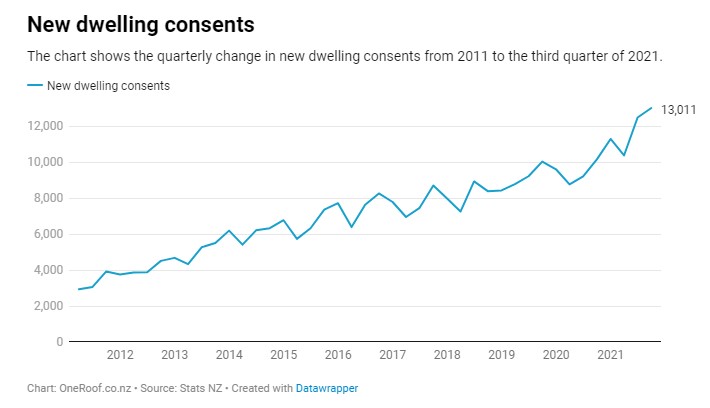
2012
移住のマイナスが少なくなり、住宅ローン金利が下がるなど、市場が少し熱を帯び始めました。投資家は依然として市場に確固たる存在感を示しており、住居の許可は床から離れますが、それほど大きな差はありません。
住宅価格の推移
このグラフは、ニュージーランドの平均的な不動産価格の推移を表しています。数値はCoreLogicより提供。

2013
市場にとって「節目」の年:純移民流入数がプラスに転じ、労働力人口が増加し、住宅ローン金利も上昇したにもかかわらず、販売と価格が加速しました。
投資家はまだ活発ですが、ファーストホームバイヤーはまだ比較的静かで、多くの人が20%のデポジット(頭金)を貯めるのに必要な年数は7年を超えました。
労働力人口
このグラフは、2011年から2021年第2四半期までの労働力人口の四半期ごとの推移を示したものです。
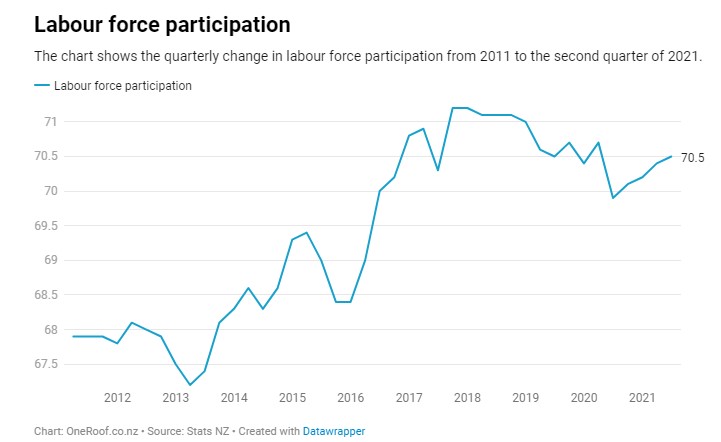
住宅建設許可件数は増加しているものの、世界金融危機による淘汰の遺産が残っており、(住宅)ストックの不足は深刻化しています。
2013年は、準備銀行がLVR(Loan to Value ratio)規制を導入し、低額デポジット(20%を未満)の借り手への住宅融資を、10%に制限する年でもあります。
2014
純移民流入数は大幅に増加しましたが、住宅ローン金利も上昇し、販売量と価格上昇率はともに低下しました。
純移民流入数の変化
グラフは、2011年から2021年第3四半期までの純移民流入数の四半期ごとの推移を示したものです。
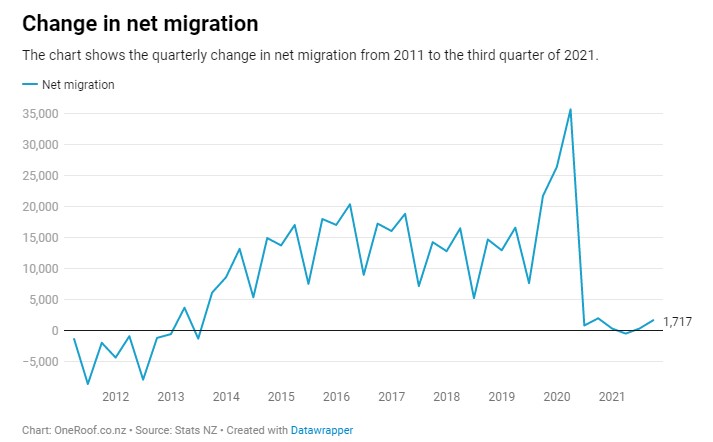
投資家は依然として活発ですが、LVR規制がファーストホームバイヤーに大きな打撃を与えています。
住宅建設許可件数は改善されましたが、過去の水準からするとまだかなり控えめなものです。
2015
住宅市場にとって好況の年:販売は好調、価格の伸びは2桁に加速し、住宅ローン金利は引き下げられ、純移民数は新たな高みに達し、労働力人口は69%を超えました。
ファーストホームバイヤーは少し回復したものの、デポジットを貯めるために必要な年数は8年を超えました。投資家は依然として強い存在感を示しています。
デポジット(頭金)の上昇
このグラフは、2011年以降の各四半期の平均世帯収入と平均不動産価格から、収入の15%を毎年貯蓄できると仮定して、20%のデポジットを貯めるのにかかる年数の推移を示したものです。
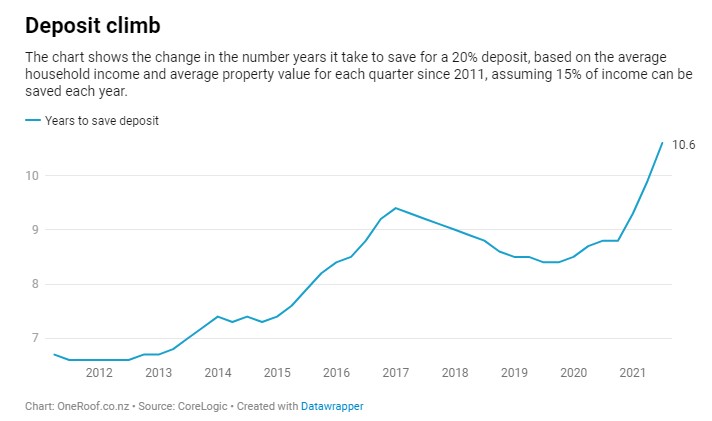
住宅建設許可が刻々と進むばかりで、住宅不足は深刻化しています。
ニュージーランド国民党は、投資目的で使用する住宅用不動産を購入後2年以内に売却した場合に課税するブライトライン・テストを導入しました。ただし、その家が購入者のメインホームである場合は例外となります。
準備銀行がLVRのルールを変更しました。オークランドの投資物件は30%のデポジットが必要である一方、それ以外の投資物件は10%から15%に引き上げられました。
2016
今年も市場のピークを迎え、売上と価格が急速に上昇しました。
移民は増え、住宅建設許可件数も増えていますが、まだ十分ではありません。住宅ローン金利は安定していますが、労働人口が増加しています。
住宅ローン金利の推移:下降と上昇
グラフは、2011年から2021年第3四半期までの、2年固定金利住宅ローンの四半期ごとの推移を示したものです。
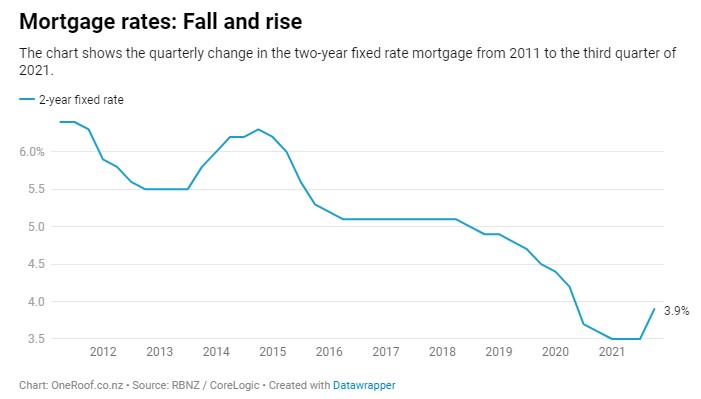
ファーストホームバイヤーは落ち着いており、頭金を貯めるのに必要な年数は9年強である一方、投資家の活動は依然堅調です。
準備銀行は再びLVRを変更し、投資物件には40%、それ以外には20%のデポジットを要求するようになりました。
2017
投資家が撤退し、全体の売上や価格が鈍化する転換期を迎えます。
デポジットを貯めるのに必要な年数が改善され、ファーストホームバイヤーが市場で大きなシェアを占めます。
ファーストホームバイヤー対投資家
住宅ローン金利は安定しており、移民流入数は緩和されるものの、依然として住宅ストックを圧迫するほどには高水準です。
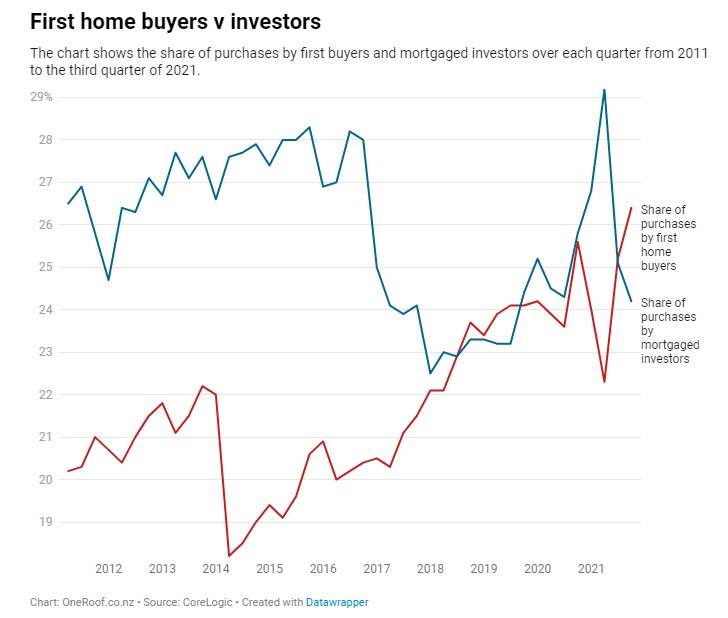
-
2018年
ほとんどの指標がかなり安定しており、市場にとって持ち合いの年。
販売数量の推移
このグラフは、2011年かこの年の第3四半期までの販売数量の四半期ごとの推移を示したものです。
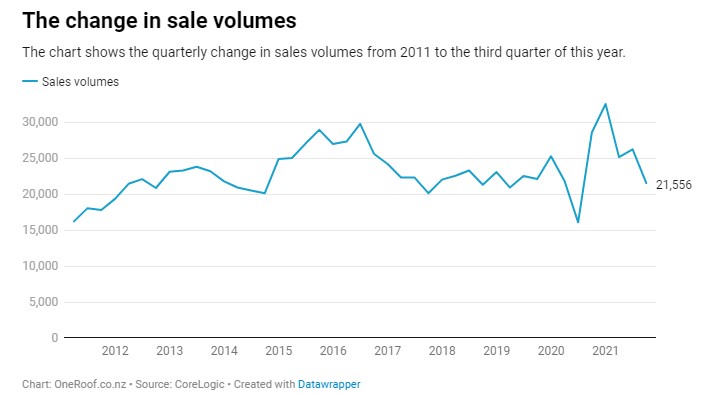
投資物件のデポジット要件は40%から35%に下がり、持ち家の場合は15%に上昇しました。新連立政権はブライトラインテストを5年に延長し、外国人バイヤー禁止令を導入しました。
2019
この年も市場はかなり安定しています。準備銀行はLVR規則をさらに緩和し(投資物件のデポジットは30%に下がり、持ち家のデポジットは20%に上がる)、ファーストホームバイヤーは市場でシェアを拡大しました。
週間家賃の変化
このグラフは、2011年から2021年第3四半期までのニュージーランドの平均週間家賃の四半期ごとの推移を示したものです。
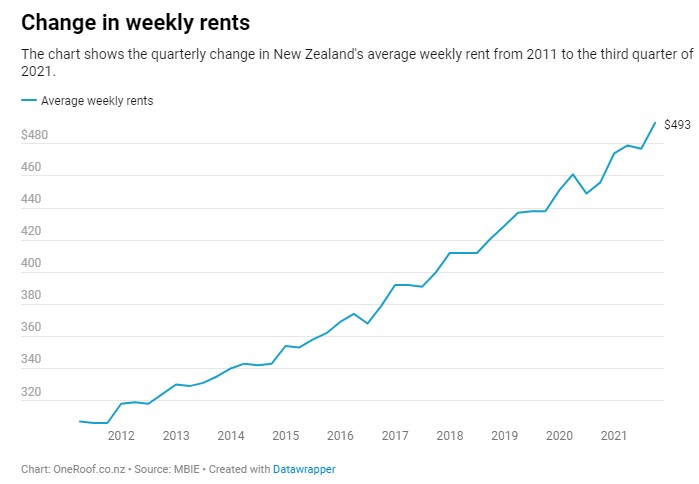
移民流入数と住宅建設許可が急増し、住宅ローン金利は低下。
政府はキャピタルゲイン税の提案を拒否するも、賃貸物件の損失に対する税制上の環状措置を導入しました。
2020
年明け早々にCovid-19が発生し、これを受けて政府と準備銀行が大きな変更を行いました。公的資金金利は0.25%に引き下げられ、LVR規制が撤廃され、住宅ローンの支払いが延期できるようになり、貸出のための資金調達プログラムが開始され、量的緩和が再導入されます。
3月末には国がロックダウンとなり、6月初旬まで規制が続きました。住宅市場は4月と5月に低迷しましたが、6月以降に回復し始めます。
投資物件は必要なデポジットが少ない(銀行独自のルールで20%程度)ことを利点としますが、健康住宅法が波紋を呼び、コストが上昇しました。
純移民流入数は減少したものの、住宅建設許可件数は堅調で、住宅ストックの不足はようやく解消に向かいます。
しかし、ファーストホームバイヤーにとっては、頭金を貯めるために必要な年数が以前のピークに戻るなど、事態はそれほど容易ではありません。
2021
市場は活況を呈しますが、2020年に導入された支援策は徐々に撤回されます。
準備銀行はLVRを復活・強化し、投資物件のデポジットを40%に戻し、持ち家のデポジットを10%に引き下げました。
また、OCR(政策金利)を7年ぶりに引き上げ、量的緩和を終了し、量的緩和を終了し、負債所得比率などの新たな融資制限を示唆しました。
金利の変動
このグラフは、2014年9月から2021年11月までの政策金利の推移を示したものです。
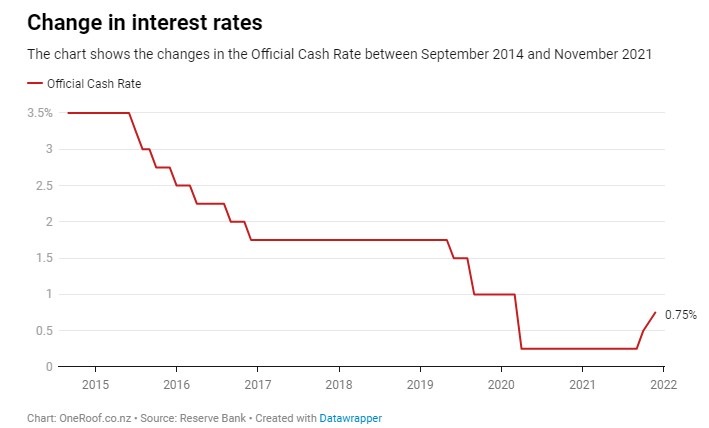
3月、政府は競争条件を公平にすることを目的とした新しい住宅政策を発表しました。投資物件が再びターゲットとなり、ブライトライン・テストは既存物件で10年に延長され(新築物件は依然として5年)、金利控除がすべての新規購入物件で廃止され、発表前に購入した物件からは段階的に廃止されます(新築物件にはまだ適用されます)。
純移民流入はほとんどなく、住宅不足はより深刻化しています。
-
結論
最近、経済を支えるために低金利の住宅ローンが必要とされていますが、裏を返せば、ニュージーランドがもっと早くから住宅を建設していれば、住宅価格高騰による格差は緩和されたかもしれない、ということです。
住宅不足は、世界金融危機後の産業淘汰の結果でもある一方、土地利用の制約や資源管理法の問題が残っています。オークランド市のユニタリープランは、このような市場の変化を促し、地震後のカンタベリー市の経験は、意思決定者が迅速に対応し、土地を開放すれば、何ができるかを示しているように思われます。最近、開発許可(資源利用承認とも)の取得要件が緩和されたことも(例えば、同じ区画に3階建ての住宅を3軒まで建てることができる)、良い方向への一歩と言えるでしょう。
キャピタルゲイン税があれば、すべてが変わっていたのでしょうか?そうかもしれません。しかし、ニュージーランドには、ブライトライン・テストという形で、いずれにせよすでにキャピタルゲイン税(CGT)の形態があります。おそらく土地税や富裕税がより効果的でしょうが、同様に重要なのは、不動産購入を阻止するためのムチではなく、他の資産に投資するための補助金でしょう。
– CoreLogic社チーフ・プロパティ・エコノミスト、ケルビン・デビッドソン氏


















































